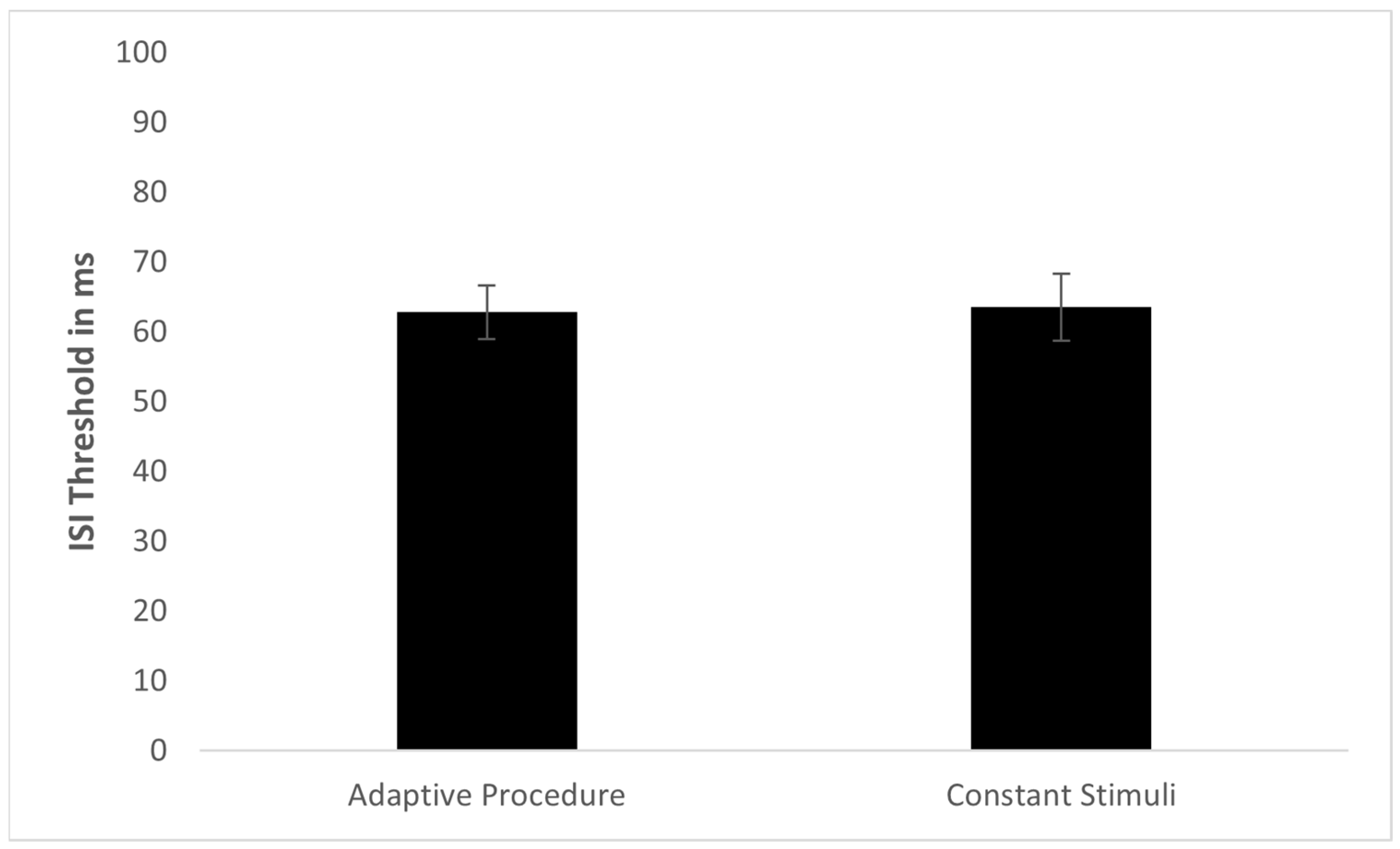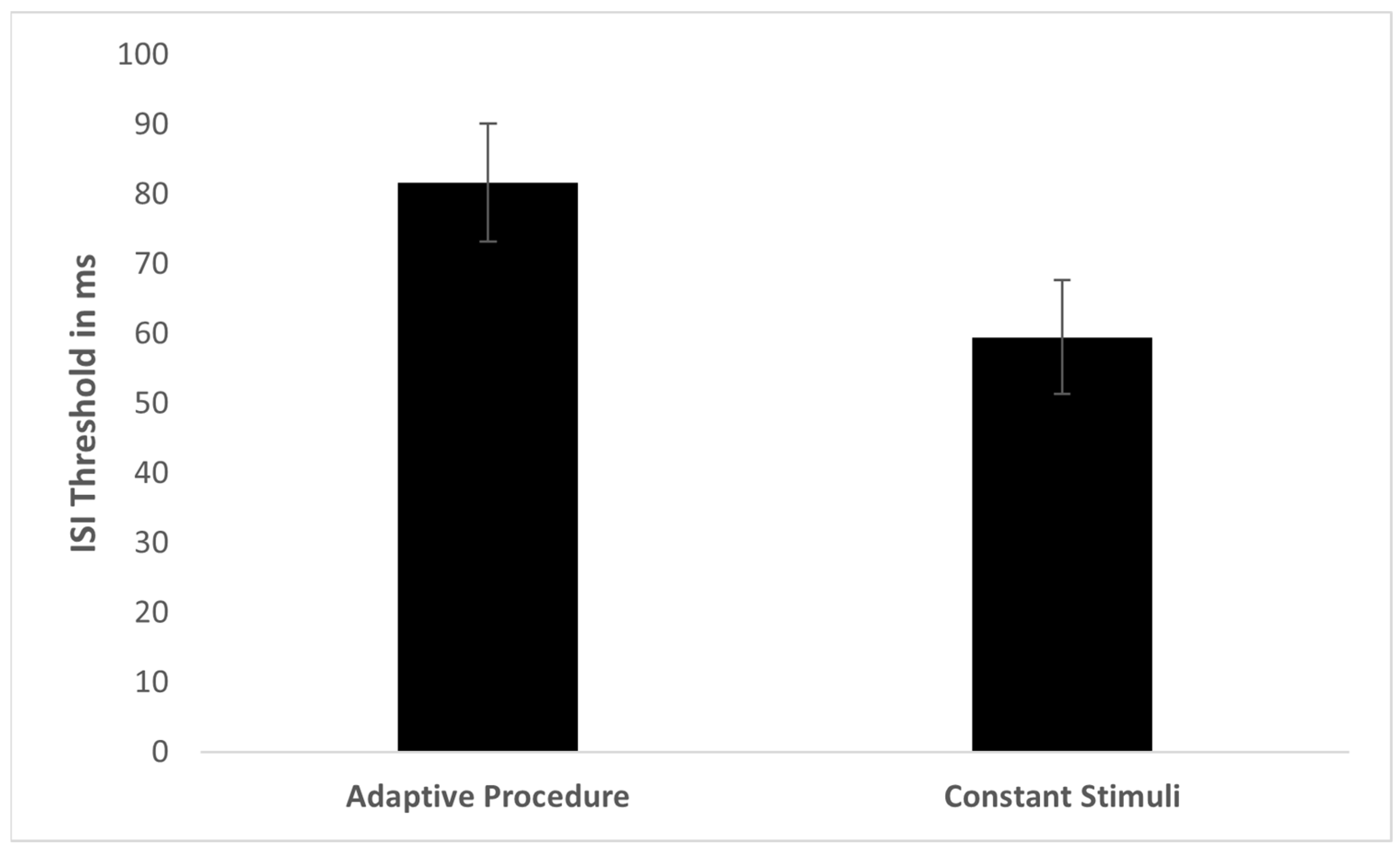The Effects of Psychophysical Methods on Spectral and Spatial TOJ Thresholds
Abstract
1. Introduction
2. Study 1: Spatial TOJ
2.1. Materials and Methods
2.1.1. Participants
2.1.2. Task, Stimuli, and Procedure
2.2. Results
2.3. Discussion
3. Study 2: Spectral TOJ
3.1. Materials and Methods
3.1.1. Participants
3.1.2. Task, Stimuli, and Procedure
3.2. Results
3.3. Discussion
4. General Discussion
4.1. Limitations and Future Studies
4.2. Conclusions
Author Contributions
Funding
Institutional Review Board Statement
Informed Consent Statement
Data Availability Statement
Conflicts of Interest
References
- Babkoff, H.; Fostick, L. The role of tone duration in dichotic temporal order judgment. Atten. Percept. Psychophys. 2013, 75, 654–660. [Google Scholar] [CrossRef] [PubMed]
- Fink, M.; Churan, J.; Wittmann, M. Assessment of auditory temporal-order thresholds—A comparison of different measurement procedures and the influences of age and gender. Restor. Neurol. Neurosci. 2005, 23, 281–296. [Google Scholar] [PubMed]
- Fink, M.; Ulbrich, P.; Churan, J.; Wittmann, M. Stimulus-dependent processing of temporal order. Behav. Process. 2006, 71, 344–352. [Google Scholar] [CrossRef]
- Fostick, L.; Babkoff, H. Different Response Patterns between Auditory Spectral and Spatial Temporal Order. Exp. Psychol. 2013, 60, 432–443. [Google Scholar] [CrossRef]
- Fostick, L.; Ben-Basat, A.L.; Babkoff, H. The effect of stimuli frequency, quality, duration, and location on temporal order judgment threshold. Psychol. Res. 2019, 83, 968–976. [Google Scholar] [CrossRef] [PubMed]
- Hirsh, I.J. Auditory perception of temporal order. J. Acoust. Soc. Am. 1959, 31, 759–767. [Google Scholar] [CrossRef]
- Hirsh, I.J.; Sherrick, C.E., Jr. Perceived order in different sense modalities. J. Exp. Psychol 1961, 62, 423. [Google Scholar] [CrossRef]
- Ben-Artzi, E.; Fostick, L.; Babkoff, H. Deficits in temporal-order judgments in dyslexia: Evidence from diotic stimuli differing spectrally and from dichotic stimuli differing only by perceived location. Neuropsychologia 2005, 43, 714–723. [Google Scholar] [CrossRef]
- Fostick, L.; Bar-El, S.; Ram-Tsur, R. Auditory temporal processing as a specific deficit among dyslexic readers. Psychol. Res. 2012, 2, 77–88. [Google Scholar] [CrossRef]
- Fostick, L.; Bar-El, S.; Ram-Tsur, R. Auditory temporal processing and working memory: Two independent deficits for dyslexia. Psychol. Res. 2012, 2, 308–318. [Google Scholar] [CrossRef]
- Fostick, L.; Eshcoli, R.; Shtibelman, H.; Nechemya, R.; Levi, H. The efficacy of temporal processing training to improve phonological awareness among dyslexic students. J. Exp. Psychol. Hum. Percept. Perform. 2014, 40, 1799–1807. [Google Scholar] [CrossRef] [PubMed]
- Fostick, L.; Revah, H. Dyslexia as multi-deficit disorder: Working memory and auditory temporal processing. Acta Psychol. 2018, 183, 19–28. [Google Scholar] [CrossRef] [PubMed]
- Reed, M.A. Speech perception and the discrimination of brief auditory cues in reading disabled children. J. Exp. Child Psychol. 1989, 48, 270–292. [Google Scholar] [CrossRef]
- Tallal, P. Auditory temporal perception, phonics, and reading disabilities in children. Brain Lang. 1980, 9, 182–198. [Google Scholar] [CrossRef]
- Ben-Artzi, E.; Babkoff, H.; Fostick, L. Auditory temporal processes in the elderly. Audiol. Res. 2011, 1, 21–23. [Google Scholar] [CrossRef]
- Fostick, L.; Babkoff, H. Temporal and non-temporal processes in the elderly. J. Basic Clin. Physiol. Pharmacol. 2013, 24, 191–199. [Google Scholar] [CrossRef]
- Szymaszek, A.; Szelag, E.; Sliwowska, M. Auditory perception of temporal order in humans: The effect of age, gender, listener practice and stimulus presentation mode. Neurosci. Lett. 2006, 403, 190–194. [Google Scholar] [CrossRef]
- Szymaszek, A.; Sereda, M.; Pöppel, E.; Szelag, E. Individual differences in the perception of temporal order: The effect of age and cognition. Cogn. Neuropsychol. 2009, 26, 135–147. [Google Scholar] [CrossRef]
- Babkoff, H.; Zukerman, G.; Fostick, L.; Ben-Artzi, E. Effect of the diurnal rhythm and 24 h of sleep deprivation on dichotic temporal order judgment. J. Sleep Res. 2005, 14, 7–15. [Google Scholar] [CrossRef]
- Fostick, L.; Babkoff, H.; Zukerman, G. Effect of 24 h of sleep deprivation on auditory and linguistic perception: A comparison with dyslexic readers and aging adults. J. Speech Lang. Hear. Res. 2014, 57, 1078–1088. [Google Scholar] [CrossRef]
- Fostick, L. The Effect of Attention-Deficit/Hyperactivity Disorder and Methylphenidate Treatment on the Adult Auditory Temporal Order Judgment Threshold. J. Speech Lang. Hear. Res. 2017, 60, 2124–2128. [Google Scholar] [CrossRef] [PubMed][Green Version]
- Fink, M.; Churan, J.; Wittmann, M. Temporal processing and context dependency of phoneme discrimination in patients with aphasia. Brain Lang. 2006, 98, 1–11. [Google Scholar] [CrossRef] [PubMed]
- Von Steinbuchel, N.; Wittmann, M.; Strasburger, H.; Szelag, E. Auditory temporal-order judgement is impaired in patients with cortical lesions in posterior regions of the left hemisphere. Neurosci. Lett. 1999, 264, 168–171. [Google Scholar] [CrossRef]
- Babkoff, H.; Fostick, L. Age-related changes in auditory processing and speech perception: Cross-sectional and longitudinal analyses. Eur. J. Ageing 2017, 14, 269–281. [Google Scholar] [CrossRef] [PubMed]
- Fostick, L.; Wechsler, S.; Peretz, E. Short-term learning effect in different psychoacoustic measures. J. Basic Clin. Physiol. Pharmacol. 2014, 25, 307–312. [Google Scholar] [CrossRef]
- Fostick, L.; Babkoff, H. Auditory spectral versus spatial temporal order judgment: Threshold distribution analysis. J. Exp. Psychol. Hum. Percept. Perform. 2017, 43, 1002–1012. [Google Scholar] [CrossRef]
- Kinsbourne, M.; Rufo, D.T.; Gamzu, E.; Palmer, R.L.; Berliner, A.K. Neuropsychological deficits in adults with dyslexia. Dev. Med. Child Neurol. 1991, 33, 763–775. [Google Scholar] [CrossRef]
- Lotze, M.; Wittmann, M.; von Steinbüchel, N.; Pöppel, E.; Roenneberg, T. Daily rhythm of temporal resolution in the auditory system. Cortex 1999, 35, 89–100. [Google Scholar] [CrossRef]
- Kolodziejczyk, I.; Szelag, E. Auditory perception of temporal order in centenarians in comparison with young and elderly subjects. Acta Neurobiol. Exp. 2008, 68, 373–381. [Google Scholar]
- Stevens, A.A.; Weaver, K. Auditory perceptual consolidation in early-onset blindness. Neuropsychologia 2005, 43, 1901–1910. [Google Scholar] [CrossRef]
- Fostick, L.; Bar-El, S.; Ben-Artzi, E.; Babkoff, H. The pattern of auditory deficit in adult dyslexic readers. In Proceedings of the International Congress of Psychology (ICP) XXIX, Berlin, Germany, 20–25 July 2008. [Google Scholar]
- Kanabus, M.; Szelag, E.; Rojek, E.; Pöppel, E. Temporal order judgment for auditory and visual stimuli. Acta Neurobiol. Exp. 2002, 62, 263–270. [Google Scholar]
- McFarland, D.J.; Cacace, A.T.; Setzen, G. Temporal-order discrimination for selected auditory and visual stimulus dimensions. J. Speech Lang. Hear. Res. 1998, 41, 300–314. [Google Scholar] [CrossRef] [PubMed]
- Shen, Y. Comparing adaptive procedures for estimating the psychometric function for an auditory gap detection task. Atten. Percept. Psychophys. 2013, 75, 771–780. [Google Scholar] [CrossRef] [PubMed]
- Watson, A.B.; Fitzhugh, A. The method of constant stimuli is inefficient. Atten. Percept. Psychophys. 1990, 47, 87–91. [Google Scholar] [CrossRef]
- Simpson, W.A. The method of constant stimuli is efficient. Atten. Percept. Psychophys. 1988, 44, 433–436. [Google Scholar] [CrossRef] [PubMed]




| a. Spatial TOJ. | |||
| Study | Stimuli | n | ISI Threshold (ms) |
| Adaptive Procedure | |||
| Fink et al. (2005) [2] | 1 ms clicks | 20 | 54 |
| Fink et al. (2005) [2] | 1 ms clicks | 20 | 52 |
| Fink et al. (2006) [3] | 1 ms clicks | 49 | 57 |
| Fostick & babkoff (2013) [4] | 15 ms 1 kHz tones | 30 | 65 |
| Fostick et al. (2014) [11] | 15 ms 1 kHz tones | 47 | 58 |
| Fostick et al. (2014) [25] | 15 ms 1 kHz tones | 20 | 67 |
| Fostick & Babkoff (2017) [26] | 15 ms; 1 kHz tones | 37 | 72 |
| Kinsbourne et al. (1991) [27] | 1 ms clicks | 21 | 47 |
| Lotze et al. (1999) [28] | 1 ms clicks | 5 | 37 |
| Lotze et al. (1999) [28] | 1 ms clicks | 5 | 21 |
| Lotze et al. (1999) [28] | 1 ms clicks | 2 | 24 |
| Szymaszek et al. (2006, 2009) [17,18] | 1 ms clicks | 17 | 68 |
| Constant Stimuli1 | |||
| Babkoff & Fostick (2013) [1] | 5 ms 1 kHz tones | 28 | 114 |
| Babkoff & Fostick (2013) [1] | 10 ms 1 kHz tones | 28 | 97 |
| Babkoff & Fostick (2013) [1] | 20 ms 1 kHz tones | 28 | 79 |
| Babkoff & Fostick (2013) [1] | 30 ms 1 kHz tones | 28 | 57 |
| Babkoff & Fostick (2013) [1] | 40 ms 1 kHz tones | 28 | 42 |
| Babkoff et al. (2005) [19] | 10 ms 1 and 1.5 kHz tones | 18 | 63 |
| Ben-Artzi et al. (2005) [8] | 15 ms 300 Hz and 600 Hz tones | 26 | 49 |
| Fostick et al. (2012) [9] | 15 ms 1 kHz tones | 40 | 68 |
| Fostick et al. (2012) [10] | 15 ms 1 kHz tones | 46 | 74 |
| Fosticket al. (2014) [25] | 15 ms 1 kHz tones | 18 | 50 |
| Fostick & Babkoff (2017) [26] | 15 ms; 0.3/0.6/1 kHz tones | 185 | 80 |
| Kolodziejczyk & Szelag (2008) [29] | 15 ms 300 Hz tones | 17 | 37 |
| b. Spectral TOJ. | |||
| Study | Stimuli | n | ISI Threshold (ms) |
| Adaptive Procedure | |||
| Fink et al. (2005) [2] | 10 ms; 800 Hz & 1.2 kHz | 20 | 15 |
| Fink et al. (2005) [2] | 10 ms; 800 Hz & 1.2 kHz | 20 | 20 |
| Fink et al. (2006) [3] | 10 ms; 600 Hz & 1.2 kHz | 45 | 21 |
| Fostick & Babkoff (2013) [4] Fostick et al. (2014) [11] | 15 ms; 1 & 1.8 kHz | 19 | 45 |
| Fostick & Babkoff (2017) [26] | 15 ms; 1 & 1.1/1.5/1.8/3.5 kHz | 99 | 88 |
| Stevens & Weaver (2005) [30] | 20 ms; 1 & 4 kHz | 11 | 19 |
| Szymaszek et al. (2006, 2009) [17,18] | 10 ms; 400 Hz & 3 kHz | 17 | 33 |
| Constant Stimuli1 | |||
| Fostick et al. (2008) [31] | 15 ms; 1 & 1.8 kHz | 50 | 2 |
| Fostick et al. (2012) [9] | 15 ms; 1 & 1.8 kHz | 40 | 46 |
| Fostick & Babkoff (2017) [26] | 5–20 ms; 1 & 1.5/1.8 kHz | 289 | 75 |
| Kanabus et al. (2002) [32] | 15 ms; 300 Hz & 3 kHz | 12 | 40 |
Publisher’s Note: MDPI stays neutral with regard to jurisdictional claims in published maps and institutional affiliations. |
© 2022 by the authors. Licensee MDPI, Basel, Switzerland. This article is an open access article distributed under the terms and conditions of the Creative Commons Attribution (CC BY) license (https://creativecommons.org/licenses/by/4.0/).
Share and Cite
Fostick, L.; Babkoff, H. The Effects of Psychophysical Methods on Spectral and Spatial TOJ Thresholds. Sensors 2022, 22, 4830. https://doi.org/10.3390/s22134830
Fostick L, Babkoff H. The Effects of Psychophysical Methods on Spectral and Spatial TOJ Thresholds. Sensors. 2022; 22(13):4830. https://doi.org/10.3390/s22134830
Chicago/Turabian StyleFostick, Leah, and Harvey Babkoff. 2022. "The Effects of Psychophysical Methods on Spectral and Spatial TOJ Thresholds" Sensors 22, no. 13: 4830. https://doi.org/10.3390/s22134830
APA StyleFostick, L., & Babkoff, H. (2022). The Effects of Psychophysical Methods on Spectral and Spatial TOJ Thresholds. Sensors, 22(13), 4830. https://doi.org/10.3390/s22134830







